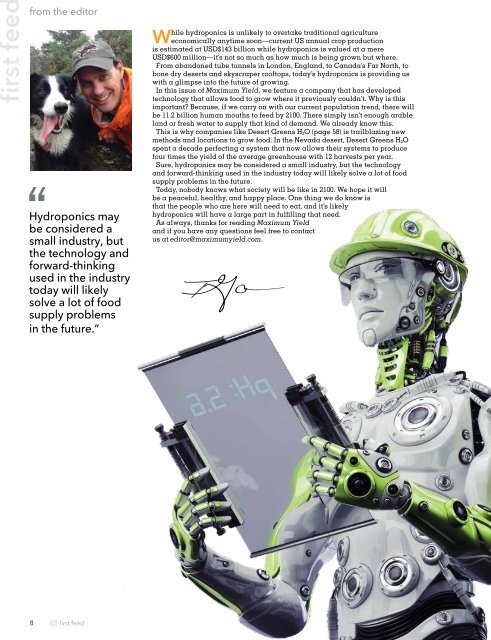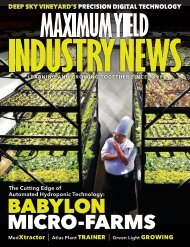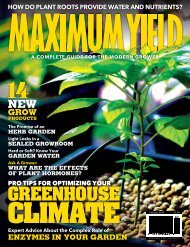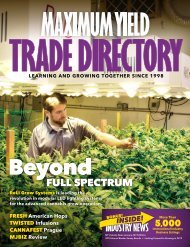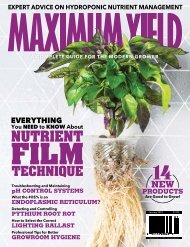Maximum Yield Canada July/August 2017
While hydroponics is unlikely to overtake traditional agriculture economically anytime soon—current US annual crop production is estimated at $143 billion while hydroponics is valued at a mere $600 million—it’s not so much as how much is being grown but where. Today, nobody knows what society will be like in 2100. We hope it will be a peaceful, healthy, and happy place.
While hydroponics is unlikely to overtake traditional agriculture economically anytime soon—current US annual crop production is estimated at $143 billion while hydroponics is valued at a mere $600 million—it’s not so much as how much is being grown but where. Today, nobody knows what society will be like in 2100. We hope it will be a peaceful, healthy, and happy place.
Create successful ePaper yourself
Turn your PDF publications into a flip-book with our unique Google optimized e-Paper software.
first feed<br />
from the editor<br />
Hydroponics may<br />
be considered a<br />
small industry, but<br />
the technology and<br />
forward-thinking<br />
used in the industry<br />
today will likely<br />
solve a lot of food<br />
supply problems<br />
in the future.”<br />
While hydroponics is unlikely to overtake traditional agriculture<br />
economically anytime soon—current US annual crop production<br />
is estimated at USD$143 billion while hydroponics is valued at a mere<br />
USD$600 million—it’s not so much as how much is being grown but where.<br />
From abandoned tube tunnels in London, England, to <strong>Canada</strong>’s Far North, to<br />
bone dry deserts and skyscraper rooftops, today’s hydroponics is providing us<br />
with a glimpse into the future of growing.<br />
In this issue of <strong>Maximum</strong> <strong>Yield</strong>, we feature a company that has developed<br />
technology that allows food to grow where it previously couldn’t. Why is this<br />
important? Because, if we carry on with our current population trend, there will<br />
be 11.2 billion human mouths to feed by 2100. There simply isn’t enough arable<br />
land or fresh water to supply that kind of demand. We already know this.<br />
This is why companies like Desert Greens H 2O (page 58) is trailblazing new<br />
methods and locations to grow food. In the Nevada desert, Desert Greens H 2O<br />
spent a decade perfecting a system that now allows their systems to produce<br />
four times the yield of the average greenhouse with 12 harvests per year.<br />
Sure, hydroponics may be considered a small industry, but the technology<br />
and forward-thinking used in the industry today will likely solve a lot of food<br />
supply problems in the future.<br />
Today, nobody knows what society will be like in 2100. We hope it will<br />
be a peaceful, healthy, and happy place. One thing we do know is<br />
that the people who are here will need to eat, and it’s likely<br />
hydroponics will have a large part in fulfilling that need.<br />
As always, thanks for reading <strong>Maximum</strong> <strong>Yield</strong><br />
and if you have any questions feel free to contact<br />
us at editor@maximumyield.com.<br />
8 first feed


